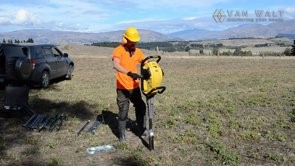

What’s the synergy between Poldark & Van Walt’s Window Sampling System?

April 8, 2015
It’s amazing that a BBC remake of Poldark could push mineral exploration into the consciousness of more than seven million people in the UK. The ‘will he, won’t he’ find copper in his family’s Cornish tin mine, has the nation on the edge of their seats, helped by the fact that Poldark himself is in his shirt sleeves helping his miners in the search for this precious mineral.
The reality is you need more than a hunky leading man, a few hammers, a donkey driven ventilation system to find copper or any other valuable mineral for that matter. Mineral exploration is the process of finding commercially viable concentrations of minerals to mine. It is an intensive, organised and professional form of prospecting and tends to be an involved process.
There are several methods of mineral exploration including:
– Geophysical – the gathering of geological data using equipment that checks for variations in gravity, magnetism, electromagnetism (resistivity of rocks) and a number of different other variables in a certain area. The most effective and widespread method of gathering geophysical data is via flying airborne geophysics.
– Remote sensing – which often uses aerial photography to assess potential mineral tracts gives the explorer orientation information like the location of tracks, roads, fences, habitation, as well as the ability to at least qualitatively map an area. More recently satellite imagery has been used to map not only the visual light spectrum over mineral exploration tenements, but spectra which are beyond the visible.
– Geochemical – the primary role of which is to find an area consistent with the mineral sought or in elements known to be associated with this mineral. Traditionally this has involved the use of sediments where regional surveys may use low sampling densities such as one sample per 100 square kilometres in the search for a target mineral. Geochemical surveys commonly use soils as the sampling media, possibly via the collection of a grid of samples over an area which are amenable to soil geochemistry. Areas which are covered by transported soils, alluvium, colluvium or are disturbed too much by human activity (roads, rail, farmland), may need to be drilled to a shallow depth in order to sample undisturbed or unpolluted bedrock.
Van Walt can help. We offer our window sampling system that is ideal for taking undisturbed samples up to 10 metres in depth in hard soils that may contain rubble, bricks or stones. Cutting heads are manufactured of hardened steel and rigidly tested to withstand 30 minutes on reinforced concrete and this uniquely designed window-less core sampler delivers samples 100cm long in a sleeve for analysis off-site.
To see how easy and effective the Van Walt Window Sampling System is watch our short film https://www.vanwalt.com/video-link/window-sampling.html .
For more information call us on +44 (0)1428 661 660 or email sales@vanwalt.com.
You might also be interested in...
Van Walt Guidelines for sampling for PFAS in Groundwater
November 13, 2024We need to make clear, that at the time of writing, there are no ISO or EN standards which deal with the sampling of groundwater for PFAS.
Read MoreSpot measurement v. continuous environmental monitoring
August 25, 2023Environmental monitoring has developed considerably over the years. From the time when a consultant went out monthly or quarterly with a dip tape to monitor the groundwater level in a borehole, wind forward...
Read MoreMeasuring Nitrates (NO3, NO3-N) in the field
June 20, 2023The interest in Nitrates is nothing new. One way or another we have been measuring them for half a century.
Read MoreVan Walt Environmental Equipment
A small selection of our environmental equipment